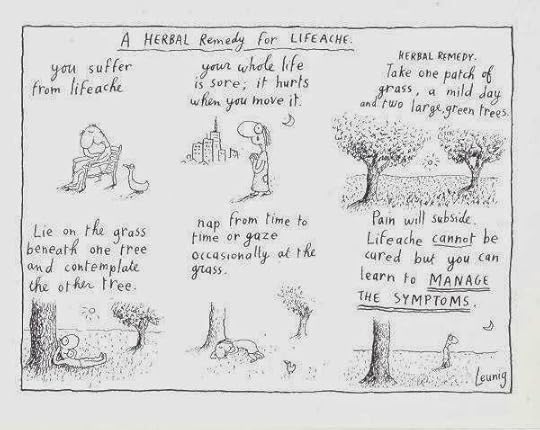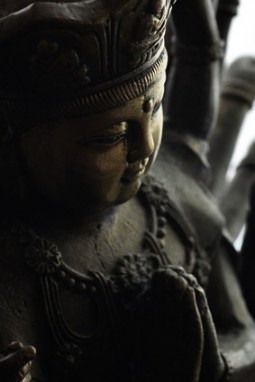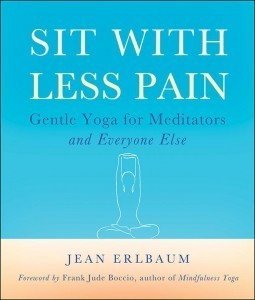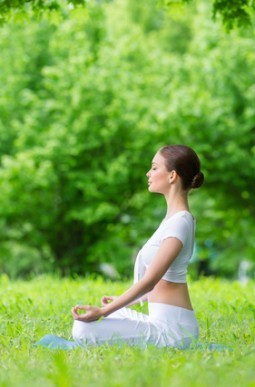Bodhipaksa's Blog, page 12
April 2, 2014
A herbal remedy for lifeache, from the brilliant Michael Leunig.

A herbal remedy for lifeache, from the brilliant Michael Leunig.
Reshared post from +Mark Tillotson
Related posts:
We did it!
Kulananda (Michael Chaskalson) on mindfulness
Geshe Michael Roach’s 16 feet
Related posts brought to you by Yet Another Related Posts Plugin.

March 31, 2014
Gratitude promotes patience
 I wasn’t surprised today to learn that a new study has found a connection between gratitude and patience. After all, if you value what you have, which is what gratitude accomplishes for us, then there’s less emotional need to go seeking something else.
I wasn’t surprised today to learn that a new study has found a connection between gratitude and patience. After all, if you value what you have, which is what gratitude accomplishes for us, then there’s less emotional need to go seeking something else.
The study, carried out by a team of researchers from Northeastern University, the University of California, Riverside, and Harvard Kennedy School, looked specifically at financial impatience. Financial impatience is a well-known phenomenon where larger rewards in the future are considered less important than smaller rewards in the present.
Participants in the study chose between receiving a larger sum in the future, or a smaller sum now. The researchers used real money so that the participants would experience real motivation (and real impatience).
Before they made their choice, the participants were randomly assigned to one of three groups where they wrote about an event from their past that made them feel grateful, or happy, or neutral.
The neutral and happy groups showed a strong preference for immediate payouts, but those feeling grateful showed more patience. For example, grateful people required $63 immediately to forgo receiving $85 in three months, whereas neutral and happy people required only $55 to forgo the future gain. Positive feelings alone were not enough to enhance patience, as happy participants were just as impatient as those in the neutral condition.
What’s more, the degree of patience exhibited was directly related to the amount of gratitude any individual felt. The more grateful a participant felt after the writing exercise, the more likely they were to wait for the delayed reward.
Normally we think of the ability to delay gratification as a function of “willpower,” but in my view willpower is overrated. When I discovered how to get myself to meditate every day — something I’d struggled with for years — the solution had nothing to do with willpower. Instead, it was to do with how I saw myself. Similarly, this study had nothing to do with willpower.
To me it’s intuitively obvious that in a moment where we’re experiencing gratitude, and therefore value what we already have, we feel less need to have more, and so we’re prepared to wait for a benefit to arrive rather than grasp after it. Gratitude makes the present moment a rich experience, and so we have a reduced need to enrich ourselves right now.
The researchers point out that the implications of the study are profound, and that it could open the way to new therapeutic techniques to address human suffering.
Assistant Professor Ye Li from the University of California, Riverside School of Business Administration, said “Showing that emotion can foster self-control and discovering a way to reduce impatience with a simple gratitude exercise opens up tremendous possibilities for reducing a wide range of societal ills from impulse buying and insufficient saving to obesity and smoking.”
Therapeutic techniques that borrowed from Buddhist practices started by tapping into teachings on mindfulness. But over time, mindfulness was seen not to be enough and so teachings on lovingkindness (metta) were increasingly incorporated. The current hot thing is compassion. It’ll be interesting to watch the addition of gratitude and appreciation (which in Buddhism are closely associated with the practice of mudita, or joyful appreciation) to therapists’ tool kits.
Related posts:
The power of gratitude (day 62)
Gratitude, creativity, and the Boys in the Basement
Gratitude, creativity, and the “boys in the basement”
Related posts brought to you by Yet Another Related Posts Plugin.

March 28, 2014
“Sit With Less Pain” by Jean Erlbaum
 Jean Erlbaum’s Sit With Less Pain is subtitled “Gentle Yoga for Meditators and Everyone Else.”
Jean Erlbaum’s Sit With Less Pain is subtitled “Gentle Yoga for Meditators and Everyone Else.”
As most meditators know, finding a comfortable way to sit in meditation for long periods of time can be challenging. We can end up futzing around with our equipment, trying out different chairs, benches, and cushions, and constantly adjusting the height and tilt of our seat, and still find that we end up with sore shoulders, or a sore neck, or an aching back. Often the problem is that we’re expecting a body that lacks flexibility to be still for long periods.
Sit With Less Pain addresses that problem, offering us exercises to bring more flexibility to the muscles, tendons, and ligaments of various parts of the body. It’s the only book I know of that does this specifically with an eye to meditating. Unlike most other yoga manuals you’ll see, this one doesn’t consist of a series of (for me and many others) impossible asanas. Although there are some recognizable asanas, I’d describe this more as a book of yoga-inspired stretching exercises.
Title: Sit With Less Pain
Author: Jean Erlbaum
Publisher: Wisdom Publications
ISBN: 9780861716791
Available from: Wisdom, Amazon.co.uk, and Amazon.com.
The descriptions are clear, and the book is amply illustrated with shaded line drawings. I was pleased to see that the figures in the illustrations resemble normal people rather than the ultra-thin, young, hyper-flexible, and invariably beautiful “yoga babes” that you’ll come across in yoga magazines. The illustrations show people of various ages, both sexes, a variety of races, and with normal (i.e. unathletic) body types.
The book is rather hefty, at 180 or so pages. And the author points out that readers might want to record themselves reciting the instructions, given the difficulty of consulting a manual while twisting one’s body in various ways. But how many people are going to go to those lengths? [Edit: I'd missed that companion CDs are available at www.sitwithlesspain.com] I can’t help thinking that a more slender book focusing on a smaller number of exercises would be useful.
There’s a relatively short section at the start, showing various ways to sit in meditation. A trouble-shooting guide for various kinds of discomfort related to specific ways of sitting might have been an asset here. There are also some breathing exercises and relaxation exercises included, although since the book is aimed at people who need to deal with pain that’s arising in their existing meditation practice I’m not sure these sections are strictly necessary.
Still, Sit With Less Pain is a very useful book, which could potentially benefit many meditators who aren’t confident about attending formal yoga classes, yet who need help dealing with the inevitable aches and pains that arise during meditation, and its imperfections are largely those inherent in the attempt to describe physical exercises in book form.
Related posts:
Science shows what meditation knows: pain is not suffering
Sit : Love : Give (Part II)
Compassion and causing pain (Day 36)
Related posts brought to you by Yet Another Related Posts Plugin.

“Sit With Less Pain” by Jean Erlebaum
 Jean Erlebaum’s Sit With Less Pain is subtitled “Gentle Yoga for Meditators and Everyone Else.”
Jean Erlebaum’s Sit With Less Pain is subtitled “Gentle Yoga for Meditators and Everyone Else.”
As most meditators know, finding a comfortable way to sit in meditation for long periods of time can be challenging. We can end up futzing around with our equipment, trying out different chairs, benches, and cushions, and constantly adjusting the height and tilt of our seat, and still find that we end up with sore shoulders, or a sore neck, or an aching back. Often the problem is that we’re expecting a body that lacks flexibility to be still for long periods.
Sit With Less Pain addresses that problem, offering us exercises to bring more flexibility to the muscles, tendons, and ligaments of various parts of the body. It’s the only book I know of that does this specifically with an eye to meditating. Unlike most other yoga manuals you’ll see, this one doesn’t consist of a series of (for me and many others) impossible asanas. Although there are some recognizable asanas, I’d describe this more as a book of yoga-inspired stretching exercises.
Title: Sit With Less Pain
Author: Jean Erlebaum
Publisher: Wisdom Publications
ISBN: 9780861716791
Available from: Wisdom, Amazon.co.uk, and Amazon.com.
The descriptions are clear, and the book is amply illustrated with shaded line drawings. I was pleased to see that the figures in the illustrations resemble normal people rather than the ultra-thin, young, hyper-flexible, and invariably beautiful “yoga babes” that you’ll come across in yoga magazines. The illustrations show people of various ages, both sexes, a variety of races, and with normal (i.e. unathletic) body types.
The book is rather hefty, at 180 or so pages. And the author points out that readers might want to record themselves reciting the instructions, given the difficulty of consulting a manual while twisting one’s body in various ways. But how many people are going to go to those lengths? I can’t help thinking that a more slender book focusing on a smaller number of exercises is needed.
There’s a relatively short section at the start, showing various ways to sit in meditation. A trouble-shooting guide for various kinds of discomfort related to specific ways of sitting might have been an asset here. There are also some breathing exercises and relaxation exercises included, although since the book is aimed at people who need to deal with pain that’s arising in their existing meditation practice I’m not sure these sections are strictly necessary.
Still, Sit With Less Pain is a very useful book, which could potentially benefit many meditators who aren’t confident about attending formal yoga classes, yet who need help dealing with the inevitable aches and pains that arise during meditation, and its imperfections are largely those inherent in the attempt to describe physical exercises in book form.
Related posts:
Science shows what meditation knows: pain is not suffering
Sit : Love : Give (Part II)
Compassion and causing pain (Day 36)
Related posts brought to you by Yet Another Related Posts Plugin.

March 27, 2014
More leaves embedded in ice

Taken on the river behind my house. The sun warms the leaves, which melt holes in the ice. In the meantime we impatiently await the arrival of Spring.?
Related posts:
Leaves in ice
More leaves in ice
Bright fall leaves on a gray day…
Related posts brought to you by Yet Another Related Posts Plugin.

March 26, 2014
For some of us, the Affordable Care Act isn't affordable
I've been fortunate. I haven't had health insurance for five years, and in that time I haven't been seriously ill. In those five years I've been to the doctor twice, and had one prescription. The total cost of all that was $360, which is less (for five years) than I'll be paying in premiums for one month.
This is the Affordable Care Act. But it's certainly not affordable for some of us. What it's going to do is to take several thousand dollars of my already strained income, and compel me to give it to a health insurance company, who will almost certainly give me nothing in return.
Of course it's possible that I might end up with some serious health problem. I'm 53. I could slip a disc, have a heart attack, have a stroke, break a limb in a fall or a car accident, or get cancer. In any of those cases I'd be glad that my losses were limited to a mere $5,000, rather than the many tens of thousands I'd otherwise have to pay. But that $5,000 dollars is not affordable under any definition of that word. I've no idea where it would come from, and I'd have no way to pay it back.
I'm not anti-ACA. I think it's a great idea in principle. For many people it cuts their insurance costs, and for many people healthcare becomes affordable for the first time — especially those with pre-existing conditions. But it does strike me as being deeply flawed in practice, and as soon as we can eject the insurance companies from the space between us and our healthcare providers, the better.?

Why I’m Jealous of My Dog’s Insurance
My Labrador goes to PetCare. Sometimes I want to go to PetCare.
Related posts:
Health “care” in the US
A Buddhist View of Health Care Reform
The end of health insurance companies?
Related posts brought to you by Yet Another Related Posts Plugin.

The Buddha in proportion

These rather gorgeous images are from an eighteenth-century book consisting of 36 ink drawings showing precise iconometric guidelines for depicting the Buddha and other figures. I stumbled across it today on a site called The Public Domain Review, which draws attention to non-copyright media of all sorts that are available for general use.
As the site points out, “The concept of the ‘ideal image’ of the Buddha emerged during the Golden Age of Gupta rule, from the 4th to 6th century. As well as the proportions, other aspects of the depiction – such as number of teeth, color of eyes, direction of hairs – became very important.”
It’s worth checking out the other images in the collection.
Related posts:
Oldest Buddha Shrine Dates Birth to 6th Century B.C.?
The first western portrayal of the Buddha?
Counternotions blog
Related posts brought to you by Yet Another Related Posts Plugin.

March 25, 2014
This is rather freaky

This is rather freaky
Reshared post from +Phillip Olsen
#illusion ?
Related posts:
Funny!
Free Market Jesus speaks…
How fast can a picture spread on the internet?
Related posts brought to you by Yet Another Related Posts Plugin.

March 24, 2014
Sumer is icumen in (so they say)

Still waiting for spring to arrive. (And we have another snowstorm forecast for tomorrow.)?
Related posts:
Guided meditation Hangout on Air
Adoption forecast
When Google ships V2 in exchange for a V1, do they include new lenses? My dark shades…
Related posts brought to you by Yet Another Related Posts Plugin.

Four tips for meditating in public
 I love meditating in public places. I’ve meditated on park benches, and on trains and buses and airplanes. I’ve done walking meditation on country lanes and on busy city streets.
I love meditating in public places. I’ve meditated on park benches, and on trains and buses and airplanes. I’ve done walking meditation on country lanes and on busy city streets.
One benefit of meditating in public places is being able to squeeze a bit more meditation into your day. If you regard meditation as something you can only do in a special room, relatively free from audible distractions, then you’re limiting the amount of time that you can spend meditating. If you regard these other times I’ve mentioned as being fair game, then you have many more opportunities for practice.
There are just a few things I’d suggest you bear in mind if you’re going to meditate in public.
If you have the expectation that you’re going to become very narrowly focused on internal sensations, like the breathing, as might happen in a quiet meditation room, then you’re probably going to be very frustrated. What we need to do is to practice a more open form of awareness where the sounds around us are part of the meditation practice. I’ll usually start by being aware of the space, and light, and sound around me. I accept the presence of whatever sounds are arising. It doesn’t matter if the sounds are ones you might conventionally think of as unpleasant, like the sounds of construction or of music that you don’t normally like — just accept that they’re present. Think of allowing them to pass, uninhibited, through the space of your mind. Sounds in fact cease to be distractions, and become what you are mindfully paying attention to. It may be that once you’ve acknowledged the sounds, you can become more narrowly focused, but it’s fine if you end up breathing while also being mindful of any sounds that are arising.
You might be interrupted. Even if you’re sitting with your eyes closed it’s possible that someone might come up and talk to you. Again, if you have an expectation that meditation is a self-evident “do not disturb” activity, as it generally is when you’re meditating in a dedicated meditation room, then you might be jarred or even angered by someone coming up and talking to you. So you have to accept that people around you are not going to know what you’re doing, and are unlikely to regard it as being special, in the way they might if they saw you sitting on a zafu in front of a Buddhist altar. So accept any disturbances with as much grace as possible.
You can do any form of meditation outdoors. I’ve mentioned that you can do walking meditation. You can do mindfulness of breathing, although as I’ve suggested it may not be as deeply focused as when you meditate in a quiet, still place. Lovingkindness practice is perfect; cultivating lovingkindness can feel much more grounded and less abstract when there are actual people around. You might find that you don’t do the usual stages (self, friend, neutral person, etc.) and go straight to the final stage of wishing all beings well.
Finally, I’d suggest avoiding meditation postures where the hands are held in special “mudras” on the knees or, even worse, held out to the sides. If you want to give the impression that meditation is some weird hippy-trippy activity, then that’s a great way to do it. But it’s not a traditional posture for Buddhist meditation, where the hands most often rest in the lap, although you can rest them on the knees as well. Generally a regular seated posture (hands on the lap) is fine for meditating on a train, bus, or park. It works, and it’s unpretentious.
 Save the mudras for the yoga studio!It’s worth considering that the Buddha probably did the majority of his meditating outdoors, in places that we might consider public. He probably didn’t meditate in city streets, except for when he was walking or begging mindfully, but he had a reputation of meditating much closer to towns than was considered normal in those days; most meditators would withdraw to very secluded places deep in the jungle or up in the mountains. And this makes me think that the Buddha meditating in that way, in those relatively accessible places, might have had the effect of “normalizing” the practice of meditation by making it visible. Perhaps we too can have the effect of normalizing meditation, making people curious about what it is that all those people sitting peacefully with closed eyes on the bus, or train, or plane, of park bench are doing. Perhaps meditating in public could be a bodhisattva activity, subtly transforming our culture.
Save the mudras for the yoga studio!It’s worth considering that the Buddha probably did the majority of his meditating outdoors, in places that we might consider public. He probably didn’t meditate in city streets, except for when he was walking or begging mindfully, but he had a reputation of meditating much closer to towns than was considered normal in those days; most meditators would withdraw to very secluded places deep in the jungle or up in the mountains. And this makes me think that the Buddha meditating in that way, in those relatively accessible places, might have had the effect of “normalizing” the practice of meditation by making it visible. Perhaps we too can have the effect of normalizing meditation, making people curious about what it is that all those people sitting peacefully with closed eyes on the bus, or train, or plane, of park bench are doing. Perhaps meditating in public could be a bodhisattva activity, subtly transforming our culture.
Related posts:
When you’re afraid of meditating
Lesbian couple to take vows in Taiwan’s first public Buddhist same-sex union
Five tips for National Relaxation Day
Related posts brought to you by Yet Another Related Posts Plugin.























